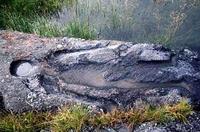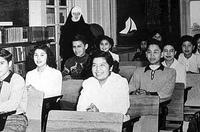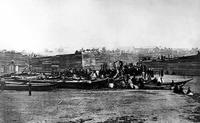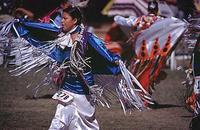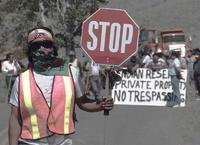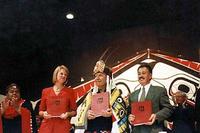First Nations of BC
FIRST NATIONS OF BC societies, cultures and languages are among the most varied and developed in the world. Their antiquity predates the rise of civilization in Europe by several millennia (see PREHISTORY). Prior to the arrival of Europeans, between 80,000 and 250,000 people lived in villages and communities spread across BC (see ABORIGINAL DEMOGRAPHY). For the most part they derived their livelihood from the land, hunting, FISHING, tending and collecting fruits and other PLANTS. Understandings of the environment, other beings and animals, and how people became human, are key aspects of the cultures of the indigenous peoples.
Social Complexity
Many early European theories of social evolution argue that the development of AGRICULTURE is the key that opens the door to civilization. In fact, until recently Euro-centric theories of social evolution assumed that development of social complexity, the process of civilization, was intrinsically bound with the development of Indo-European-style agriculture. We now know that the development of human cultures is far more complex and multifaceted than a simplistic unilineal evolution from small unorganized bands of hunters to late-20th-century capitalist society.
In what we now know as BC, highly complex cultures emerged that were based on hunting and gathering, not agriculture. There was great knowledge of plant husbandry among the indigenous peoples of BC—in fact, recent evidence suggests that the first people understood principles of plant husbandry quite well—but these societies were able to generate social surpluses without having to resort to agricultural modes of production. Harvesting technologies and ecological knowledge, refined over the course of several millennia, permitted extensive and sustainable harvesting and processing of natural resources until the industrial resource exploitation was implanted in the late 19th and early 20th centuries. It is important to recognize that hunting and fishing are about more than just subsistence. They are a way of knowing, a way of thinking about human beings in relation to other beings. This is a fundamental difference between the resource-extractive way of living that defines modern capitalist societies and the indigenous modes of subsistence.
Anthropological models normally divide the indigenous societies of BC into 3 culture areas (defined in terms of commonly shared culture traits and environment): Northwest Coast, Sub-Arctic, and Plateau. Each area was also typified by a unique form of social organization. Even though these types of models tend to ignore the historical processes of colonization, they are useful in organizing cultures and societies for the purpose of comparative analysis.
The Northwest Coast extends from the delta of the COPPER R in the Gulf of Alaska to the mouth of the Chetco R on the southern Oregon coast. Practically two-thirds of the indigenous population of BC lived along the coast zone. This was a region of abundance well known for its SALMON streams and RIVERS and temperate RAIN FORESTS. The typical form of social organization on the coast was the chiefdom, in which the political authority of the group is vested in chiefs or chiefly families. Most of these societies were divided into 3 basic classes: chiefly families, commoners and slaves (see SLAVERY). Membership in the family groups, essentially multigenerational kin groups that lived in the classic plank longhouse (see ARCHITECTURE, ABORIGINAL), was determined differently in northern than in southern BC. Membership in household groups of North Coast peoples, such as the TSIMSHIAN and the HAIDA, was determined through matrilineal descent (calculated through one's mother). On the Central and South coasts—among the HEILTSUK, SALISHAN and Kwak'wala-speaking peoples, for example—household membership was based on a bilateral kinship system (calculated through mother and father). The societies that developed along coastal BC were highly complex, sedentary hunting-gathering societies. Coastal peoples maintained permanent winter villages for thousands of years before the present, with populations ranging from 100 to 500 people. Effective political authority was vested at the household level. Each household maintained a set of territories in the surrounding region. House territories were clearly demarcated collective property that contained fish, animal, plant and spiritual resources. Access to and use of these resources was strictly controlled. In effect, no area of the coast was not property at the time Europeans arrived.
The peoples of the Plateau, or southern Interior, made up about 25% of BC's aboriginal population. The region, bounded on the west by the COAST MTS and on the east by the ROCKY MTS, is made up of a series of connected north–south valleys and plateaus. The region is environmentally diverse, containing zones ranging from sagebrush deserts to sub-boreal SPRUCE forests (see also BIOGEOCLIMATIC ZONES; ECOREGION CLASSIFICATION SYSTEM). The peoples of the Plateau maintained semi-permanent winter villages. Typically these villages were located near key salmon-fishing sites. Unlike on the coast, however, social organization was not hierarchical. Political authority was vested in extended household groups and leadership relied upon persuasion, not force or heredity. Membership in these kin-based groups was far more fluid and contingent than it was on the coast. Because kinship was determined bilaterally, people could (and often did) change allegiances. This mobility militated against the institutionalization of hereditary leadership. Essentially, chiefs and headmen were managers of specific activities for which they had specialized knowledge.
People of the northern Interior lived in the least populated region of aboriginal BC, with less than 10% of the population. The region was defined by northern boreal forests of spruce, FIR and PINE. Little rain falls in the region (less than 40 cm per year). The ground is snow-covered for 6 months of the year (see CLIMATE). Yet the peoples living in this region developed a detailed ecological knowledge of their environment and of the wildlife they relied upon that enabled them to prosper as nomadic hunter-gathers. They developed social strategies characterized by flexibility and informal institutional arrangements. The basic social unit in the northern Interior was the small, self-sufficient group of 20 to 30 (rarely more than 50) related people. These groups were dispersed over the land during winter to hunt and trap. In the summer, larger encampments of up to several hundred gathered near LAKES and rivers for fishing. A key aspect of this form of social organization was egalitarianism. There were no formal inherited leadership positions. Leaders were people who knew something, not bosses. Thus leadership shifted from task to task in accordance with individual skill and knowledge. Following the arrival of Europeans, all of these societies went through major periods of disruptions, crisis and transformation. Despite being alienated and displaced within their own territories, the First Nations of BC maintained a deep-rooted connection with their pasts and it is this strength that they draw upon in their current struggle for self-determination (see ABORIGINAL RIGHTS).
Origins: Sacred Histories and Western Science
There is a major epistemological difference underlying the origin stories of indigenous peoples in BC and the scientific theories of the peopling of the Americas. First Nations are less concerned about "where" people come from than with "how" people came to be fully human, how they have learned to share power with other animals and other humans. Western science begins with the questions of when and how did people arrive in the Americas. While this is an interesting and theoretically useful question, it also reflects the colonial past (and present) of the Americas, whether intended or not. The focus on how people first arrived reinforces the notion of the Americas as "new lands" into which successive waves of migrants have come. The oral traditions of indigenous peoples, however, shed light on the process that transformed their ancestors into fully human beings. In essence, Euro-American science presents the history of the Americas as a history of migration and population dynamics. Aboriginal history explores the birth of human culture.
Bill REID, the Haida artist, recounts through sculpture the story of RAVEN and the first humans. In this story Raven, the trickster and creator, spots a large CLAM shell full of frightened creatures left on the beach after the retreat of the waters of the great flood. Raven swoops down to investigate and, upon finding the terrified creatures, coaxes and coerces them to come out and explore the new world. Realizing that there are no women among them, Raven flies the creatures to North Island (also known as Langara Island) where he cajoles them into a sexual experience with CHITONS. Later, the chitons give birth to the original Haidas. Raven also figures in Tsimshian stories of origins. One of Raven's, or Tx'msm's, accomplishments was the freeing of the sun from a box in the Sky Chief's house. He also brought the people fire and taught them how to catch EULACHON. The people of the Interior Plateau (ST'AT'IMC, SECWEPEMC, TSILHQOT'IN, Nicola, etc) explain their origin in terms of the separation of people from the rest of nature. They received mortality as the price for guaranteed salmon runs and sunlight. Among the NUXALK (Bella Coola) there is a sequence of family histories for each of the "ancestral families" from which present-day Nuxalk reckon their family lineage. Each family history, or symayusta, describes the descent to Earth of one of the first ancestors. In these stories, groups of brothers and sisters are brought to life by a creator, then dropped on a mountaintop to populate the world. They arrive dressed in the cloaks of birds or animals and carry with them some food, tools and special knowledge for the world's future inhabitants. The first ancestors built villages at the foot of the MOUNTAINS and took territory from the surrounding region for subsistence activities. All of these traditions focus on "becoming" human. This is not simply a biological process; it is an important social and cultural process in which the ancestors become self-conscious of their place in an already existing world. The key figures in this transformation are typically tricksters, such as Raven or COYOTE, who act more as midwife than creator.
Euro-American scientific models, on the other hand, focus on when and how people arrived in the Americas. It is widely accepted within anthropological and archaeological circles that the first people in the Americas came from Asia. They are believed to have travelled across the Bering Strait during periods when intensification of the Ice Ages lowered the sea level and transformed the strait into a grassy steppe called Beringia. Evidence used to date the movement of people into the Americas includes physiological, linguistic and archaeological data. Physiological data, primarily relating to teeth, has been used to link populations of indigenous Americans to populations from northeast Asia. According to the physical anthropologist Christy Turner, indigenous Americans share a tooth pattern (sinodont) with prehistoric and contemporary peoples of China. This evidence suggests that indigenous Americans have inhabited the Americas for at least 20,000 years (see ARCHAEOLOGY). Linguistic data are used to determine what one might think of as a conceptual history of a language. Using vocabulary and grammatical structures, linguists try to determine the degree of similarity between languages. The underlying assumption is that language diversification proceeds slowly. Thus the existence of a high degree of linguistic diversity in the Americas would suggest a fairly profound time depth to human habitation (see FIRST NATIONS LANGUAGES). It is difficult if not impossible to actually determine how long it might take for a common ancestral language to diversify into distinct languages. Even so one anthropologist, Joseph H. Greenberg, has argued that the indigenous languages of the Americas all stem from 3 macro-families. Suggesting that all the indigenous languages of the Americas stem from a small group of proto-languages pushes back the time of first occupation beyond 20,000 years to nearly 50,000 years BP (Before Present). Archaeologists generally agree that people have inhabited the Americas for at least 12,000 years. This is a rather conservative date given recent archaeological data that could push the earliest date back several tens of thousands of years. In BC, the earliest archaeological date of human occupancy is 11,500 BP (+/- 120 years) at the CHARLIE LAKE CAVE site in the PEACE R district. Evidence from coastal sites also shows dates approaching 10,000 years BP (NAMU, 9,800 BP; GLENROSE, 8,250 BP; QUEEN CHARLOTTE ISLANDS 9,300 BP).
From the perspective of Euro-American science, the antiquity of aboriginal cultures is no longer in question. Even the most conservative estimates of first arrival are truly beyond the ability of human imagination. The notion that indigenous peoples have been here since time immemorial is no less fantastic than academic debates over stone shards and the remains of fire sites. The reality is that Europeans arrived in the Americas to find a complex variety of highly developed societies. The process by which indigenous lands were expropriated and the people displaced is called colonialism.
Colonialism and Resource Appropriation
The history of relations between non-aboriginal newcomers and First Nations has revolved around the exploitation and appropriation of the natural resources of BC. Initially resource extraction was organized by First Nations groups themselves. Resources were exchanged for commodities such as iron tools, blankets or other trade goods. However, the development of industrial resource extraction in the form of commercial FISHING, MINING and the FOREST INDUSTRY fundamentally altered relations between non-aboriginal newcomers and First Nations. No longer valued as trading partners, First Nations were slotted into the developing resource economy as a subordinate part of a growing industrial LABOUR FORCE segregated by race, ethnicity and gender. The early maritime-based FUR TRADE structured first contacts between Europeans and First Nations (from 1774 to 1858). In this period a European-based mercantile capitalism articulated with an indigenous kin-ordered mode of production, a system of production in which the control over labour power and the production of trade goods remained under the control of the aboriginal American traders who were for the most part "chiefs." They mobilized their followers and personal contacts to deliver SEA OTTER pelts, and their power grew with the development of the trade. The merging of these 2 modes of production—one based on the family and one based on European capitalism—produced new wealth and intense inflation for both First Nations and Europeans.
As Europeans prospered from the fur trade and developed industrial enterprises, First Nations people lost control over trade and were displaced by a settler-based industrial capitalism. The change from colonies in which Europeans exploited indigenous labour power to colonies of settlement followed the discovery of GOLD in the 1850s. By the early 1860s mining, forestry and fishing had supplanted the fur trade to become the backbone of BC's settler economy. Indigenous control of commercially valuable land and resources was almost completely destroyed by the 1880s through a variety of legal (and extra-legal) measures introduced by Canada and the provinces. One of the most insidious changes was the creation of the legal category of "food fishing" in the 1880s under the provisions of the Canada Fisheries Act (see FISHERIES JURISDICTION; FISHERIES POLICY). Under the provisions of the Act, aboriginal fishers were prohibited from selling fish caught within their traditional fisheries. Despite having never been universally applied (many First Nations have continued to sell fish caught under the so-called food fish permits), the intention and result of this regulation was to shift ownership of the resource from traditional and customary ownership by First Nations into the hands of industrial capitalist fishing firms (owned and operated by US and British financial interests), which were then able to distribute fishing "rights" to fishers loyal to the companies. At the same time as First Nations' control over their resources and territories were being usurped, First Nations people were being integrated into every major resource industry in BC as workers and owner-operators.
The Legacy of Colonialism
The impact of BC's colonial relationship with indigenous peoples is starkly revealed in basic social indicators such as income, health and interactions with the criminal justice system. Often the dramatic gaps between First Nations and other Canadians is presented as though this were the problem. In reality this is a symptom of a far bigger problem: the disruption, degradation and destruction of aboriginal societies by an encroaching settler state. The average income of First Nations people is only 70% of the average income of other Canadians. The household income of First Nations families is 40% lower than the national average ($21,800 for First Nation families versus $38,000 for other Canadian families). The source of income is also a good indicator of social inequalities. In BC, aboriginal people (especially those living on RESERVES) receive a higher portion of their income in government transfer payments (employment insurance, PENSIONS or social assistance) than from earned income (wages, salaries or self-employed income). Health is another area in which significant differences exist between aboriginal people and members of mainstream society. Illnesses resulting from poverty, overcrowding and poor housing have led to chronic and acute respiratory diseases, which take a heavy toll among aboriginal people. The standardized death rate for BC's aboriginal population is more than double that of the general population (15.9 versus 6.6 deaths per 1,000 population). The average age of death is more than 20 years below that of the average non-aboriginal Canadian. The rate of infant mortality, though improved, is still nearly 3 times the Canadian average (17.5 versus 7.9 per 1,000). More than 33% of all aboriginal deaths are related to violence (compared with 8% in mainstream society). These statistics highlight a significant discrepancy between non-aboriginal and aboriginal Canadians.
Interactions between First Nations and the criminal-law system of Canada also reveal structural inequalities. This occurs at both a collective and an individual level. On the collective level, the right to vote in federal elections was denied to all status Indians until the early 1960s. Land claims activity was criminalized between 1927 and 1951. And aboriginal children were forcibly removed from their home communities and placed in RESIDENTIAL SCHOOLS. The result of criminalizing indigenous forms of social organization, combined with the expropriation of First Nations' territories, is reflected in the disproportionate number of aboriginal people incarcerated in Canada. As of 1996 aboriginal people accounted for slightly less than 3% of the total Canadian population. However, they accounted for 12% of federal and 20% of provincial admissions to PRISONS. Each stage of the judicial process is marked by a disproportionate number of aboriginal people. Careful studies of the judicial process have clearly demonstrated that if an individual is aboriginal, his or her chance of being incarcerated is higher than among any other group of Canadians.
Facing the Future
Confronting the problems faced by aboriginal peoples will require a commitment on the part of mainstream Canada to settle their outstanding claims and to recognize in practice their existing aboriginal rights. An important first step is to accelerate the process of treaty negotiations, thereby beginning the process of dismantling the colonial apparatus of the Canadian state. Serious negotiations between First Peoples and the governments of BC and Canada began only in 1992, following the election of the NDP. For most of BC's history the government has refused to recognize aboriginal rights, let alone negotiate treaties. Gov James DOUGLAS signed 14 treaties with First Nations on VANCOUVER ISLAND during the period 1850–1854 (see DOUGLAS TREATIES). However, upon joining CONFEDERATION the provincial government refused to recognize aboriginal rights, essentially stalling the resolution of claims until 1992, when the BC TREATY COMMISSION Agreement was signed by representatives of the First Nations Summit and the provincial and federal governments. That agreement set in motion a process of negotiation that continues.
The final passage of the NISGA'A TREATY between BC, Canada and the NISGA'A in 1999 signals a new beginning for the people of BC. Though this treaty was completed outside the BC Treaty Commission process, it has the potential to transform relations between First Peoples and other British Columbians. In light of recent court cases, such as the 1997 DELGAMUUKW decision, the Nisga'a Treaty may well come to be seen as a rather conservative document. Nonetheless it is an undeniably important step toward the development of aboriginal self-determination. While the treaty process and self-determination are not panaceas for all the past wrongs, they are an important place to start, though most people agree that if they are going to have any meaningful remedial effect on the experience of First Nations social inequality, they must be built upon a solid economic and resource base.
The 1997 Supreme Court of Canada ruling in the Delgamuukw case lays the basis for a fundamental change in Canadian law that could vastly improve the economic situation of First Nations. The court found that aboriginal people have a right to fair compensation for lands expropriated by the Canadian state, that they have a right to use their traditional lands as they see fit, and that their oral traditions should be accorded the same evidentiary weight as written sources in legal cases concerning aboriginal rights and title. This decision may well usher in a new era of economic and political co-operation between First Nations and the non-aboriginal peoples of BC. At the very least it can be read as the beginning of a process of reconciliation in which mainstream BC (and, by extension, Canada) finally accepts its complicity in the process of colonialism.
See chart, "First Nations of BC."
by Charles R. Menzies

